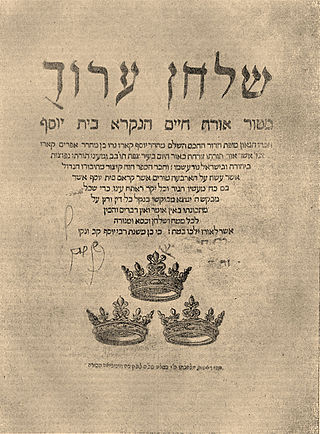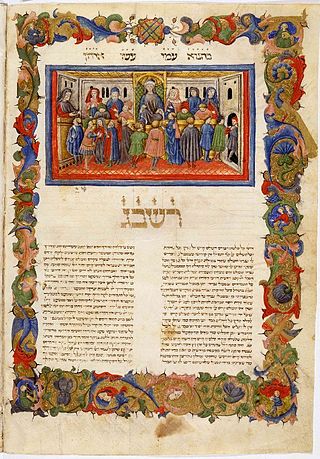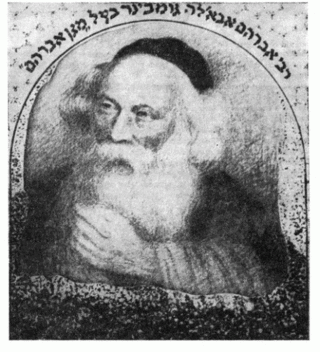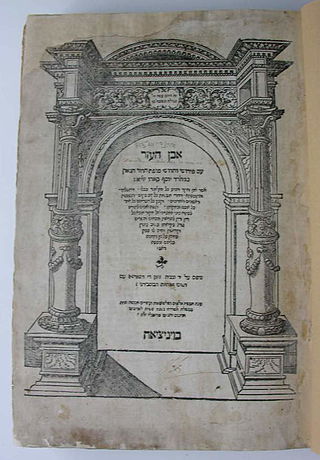Halakha, also transliterated as halacha, halakhah, and halocho, is the collective body of Jewish religious laws that are derived from the Written and Oral Torah. Halakha is based on biblical commandments (mitzvot), subsequent Talmudic and rabbinic laws, and the customs and traditions which were compiled in the many books such as the Shulchan Aruch. Halakha is often translated as "Jewish law", although a more literal translation of it might be "the way to behave" or "the way of walking". The word is derived from the root which means "to behave". Halakha not only guides religious practices and beliefs, it also guides numerous aspects of day-to-day life.

Rabbinic literature, in its broadest sense, is the entire spectrum of rabbinic writings throughout Jewish history. However, the term often refers specifically to literature from the Talmudic era, as opposed to medieval and modern rabbinic writing, and thus corresponds with the Hebrew term Sifrut Chazal. This more specific sense of "Rabbinic literature"—referring to the Talmudim, Midrash, and related writings, but hardly ever to later texts—is how the term is generally intended when used in contemporary academic writing. The terms mefareshim and parshanim (commentaries/commentators) almost always refer to later, post-Talmudic writers of rabbinic glosses on Biblical and Talmudic texts.

The Shulchan Aruch, sometimes dubbed in English as the Code of Jewish Law, is the most widely consulted of the various legal codes in Judaism. It was authored in Safed by Joseph Karo in 1563 and published in Venice two years later. Together with its commentaries, it is the most widely accepted compilation of halakha or Jewish law ever written.

The Mishnah Berurah is a work of halakha by Rabbi Yisrael Meir Kagan. It is a commentary on Orach Chayim, the first section of the Shulchan Aruch which deals with laws of prayer, synagogue, Shabbat and holidays, summarizing the opinions of the Acharonim on that work.

Jacob ben Asher, also known as Ba'al ha-Turim as well as Rabbi Yaakov ben Raash, was an influential Medieval rabbinic authority. He is often referred to as the Ba'al ha-Turim, after his main work in halakha, the Arba'ah Turim.

Arba'ah Turim, often called simply the Tur, is an important Halakhic code composed by Yaakov ben Asher. The four-part structure of the Tur and its division into chapters (simanim) were adopted by the later code Shulchan Aruch. This was the first book to be printed in Southeast Europe and the Near East.
In Jewish law and history, Acharonim are the leading rabbis and poskim living from roughly the 16th century to the present, and more specifically since the writing of the Shulchan Aruch in 1563 CE.

Rabbi Moses Isserles, also known by the acronym Rema, was an eminent Polish Ashkenazi rabbi, talmudist, and posek.
Yalkut Yosef is an authoritative, contemporary work of Halakha, providing a detailed explanation of the Shulchan Aruch as based on the halachic rulings of the former Rishon LeTzion Rav Ovadia Yosef. It was written by Rabbi Yitzhak Yosef, his son.
David ha-Levi Segal, also known as the Turei Zahav after the title of his significant halakhic commentary on the Shulchan Aruch, was one of the greatest Polish rabbinical authorities.
Yoreh De'ah is a section of Rabbi Jacob ben Asher's compilation of halakha, Arba'ah Turim around 1300. This section treats all aspects of Jewish law not pertinent to the Hebrew calendar, finance, torts, marriage, divorce, or sexual conduct.. Yoreh De'ah is therefore the most diversified area of Jewish law. Later, Rabbi Yosef Karo modeled the framework of his own compilation of practical Jewish law, the Shulchan Aruch, after the Arba'ah Turim. Many later commentators used this framework, as well. Thus, Yoreh De'ah in common usage may refer to an area of halakha, non-specific to Rabbi Jacob ben Asher's compilation.

Abraham Abele Gombiner, known as the Magen Avraham, born in Gąbin (Gombin), Poland, was a rabbi, Talmudist and a leading religious authority in the Jewish community of Kalisz, Poland during the seventeenth century. His full name is Avraham Abele ben Chaim HaLevi from the town of Gombin. There are texts that list his family name as Kalisz after the city of his residence. After his parents were killed in 1655 during the aftermath of the Chmielnicki massacres of 1648, he moved to live and study with his relative in Leszno, Jacob Isaac Gombiner. From there he moved to Kalisz where he was appointed as Rosh Yeshiva and judge in the tribunal of Rabbi Israel Spira.

Even Ha'ezer is a section of Rabbi Jacob ben Asher's compilation of halakha, Arba'ah Turim. This section treats aspects of Jewish law related to marriage, divorce, and sexual conduct. Later, Rabbi Yosef Karo modeled the framework of his own compilation of practical Jewish law, the Shulchan Aruch, after the Arba'ah Turim. Many later commentators used this framework as well. Thus, "Even Ha'ezer" in common usage may refer to an area of halakha non-specific to Rabbi Jacob ben Asher's compilation.
Choshen Mishpat is the Hebrew for "Breastplate of Judgement". The term is associated with one of the four sections of Rabbi Jacob ben Asher's compilation of halakha, Arba'ah Turim. This section treats aspects of Jewish law pertinent to finance, torts, legal procedure and loans and interest in Judaism. Later, Rabbi Yosef Karo modeled the framework of his own compilation of practical Jewish law, the Shulkhan Arukh, after the Arba'ah Turim. Many later commentators used this framework as well. Thus, Choshen Mishpat in common usage may refer to an area of halakha, non-specific to Rabbi Jacob ben Asher's compilation.
Yaakov ben Yaakov Moshe Lorberbaum of Lissa (1760-1832) was a rabbi and posek. He is most commonly known as the "Ba'al HaChavas Da'as" or "Ba'al HaNesivos" for his most well-known works, or as the "Lissa Rav" for the city in which he was Chief Rabbi.

Joseph ben Meir Teomim was a Galician rabbi born at Lemberg. While still young he succeeded his father in the position of preacher and rabbinical instructor in the yeshivah of Lemberg. Later he went to Berlin, where he stayed several years in the bet ha-midrash of Daniel Itzig. Then he resumed his former position at Lemberg, and in 1782 was appointed rabbi at Frankfurt an der Oder, where he remained until his death. He was buried in the Jewish cemetery at Frankfurt/Oder.
David Solomon Eibeschutz was born in Ozeriany, Polish–Lithuanian Commonwealth in 1755.

Sifrei Kodesh, commonly referred to as sefarim, or in its singular form, sefer, are books of Jewish religious literature and are viewed by religious Jews as sacred. These are generally works of Torah literature, i.e. Tanakh and all works that expound on it, including the Mishnah, Midrash, Talmud, and all works of halakha, Musar, Hasidism, Kabbalah, or machshavah. Historically, sifrei kodesh were generally written in Hebrew with some in Judeo-Aramaic or Arabic, although in recent years, thousands of titles in other languages, most notably English, were published. An alternative spelling for 'sefarim' is seforim.
In Jewish law, a posek is a legal scholar who determines the application of halakha, the Jewish religious laws derived from the written and Oral Torah in cases of Jewish law where previous authorities are inconclusive, or in those situations where no clear halakhic precedent exists.
The following outline is provided as an overview of and topical guide to Judaism:










